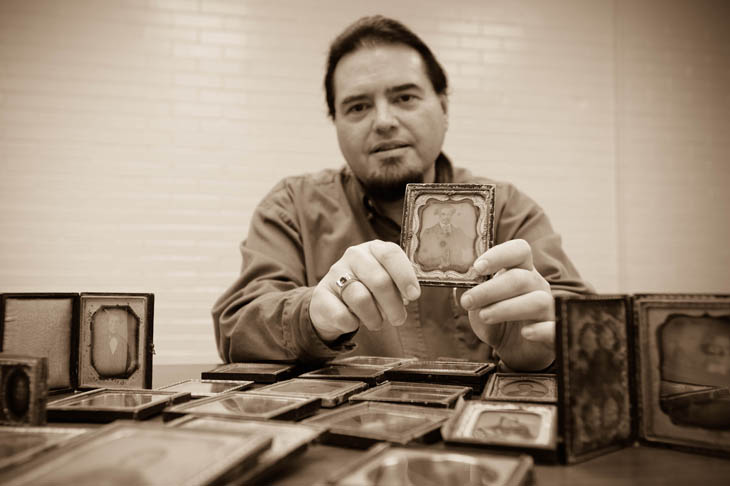Digging through daguerreotypes

Tulane executive secretary Gilbert Estrada has a collection of 500 antique photographs and one big mystery. (Photo by Sally Asher)
A picture is worth a thousand words, but in some cases, Gilbert Estrada would be happy with just two words a first and last name. Still, Estrada has been able to pull information from some of the 500 antique photographs he has collected for the last 30 years.
Estrada, who has worked at the Tulane University School of Medicine for 20 years as an applications specialist and most recently, executive secretary, was drawn to collecting photographs because according to him, “they are frozen moments in time, never to be relived again in the exact same way.”
He has daguerreotypes (developed on silver-coated metal plates), ambrotypes (developed directly on pieces of glass) and tintypes (developed directly on tin), but daguerreotypes are his favorite. They were invented by Louis Daguerre in 1839 and were the first commercially feasible form of photography.
Estrada"s favorite photograph in his collection proves to be his biggest mystery. It is an image of an elegantly dressed African American man, possibly in his late 20s, circa 1860.
The developing techniques are significant, demonstrating that the man was wealthy. The photograph was tinted and embellished with gold paint to highlight his gold watch chain, and the plate was pricked with a pin to indicate the man was wearing a diamond cravat pin. The rare metal matting shows the British Union Jack, the American flag, a British lion and an American eagle.
Estrada wrote a fictional story involving the man for Country Roads Magazine, and the image was used in the documentary "Faubourg Treme the Untold Story of Black New Orleans."
Producing daguerreotypes at the time was extremely dangerous; many photographers became ill from chemical exposure and died.
“It was truly dying for your art,” Estrada says. He hopes his form of exposure will bring some of his photographs back to life.
Estrada, who has worked at the Tulane University School of Medicine for 20 years as an applications specialist and most recently, executive secretary, was drawn to collecting photographs because according to him, “they are frozen moments in time, never to be relived again in the exact same way.”
He has daguerreotypes (developed on silver-coated metal plates), ambrotypes (developed directly on pieces of glass) and tintypes (developed directly on tin), but daguerreotypes are his favorite. They were invented by Louis Daguerre in 1839 and were the first commercially feasible form of photography.
Estrada"s favorite photograph in his collection proves to be his biggest mystery. It is an image of an elegantly dressed African American man, possibly in his late 20s, circa 1860.
The developing techniques are significant, demonstrating that the man was wealthy. The photograph was tinted and embellished with gold paint to highlight his gold watch chain, and the plate was pricked with a pin to indicate the man was wearing a diamond cravat pin. The rare metal matting shows the British Union Jack, the American flag, a British lion and an American eagle.
Estrada wrote a fictional story involving the man for Country Roads Magazine, and the image was used in the documentary "Faubourg Treme the Untold Story of Black New Orleans."
Producing daguerreotypes at the time was extremely dangerous; many photographers became ill from chemical exposure and died.
“It was truly dying for your art,” Estrada says. He hopes his form of exposure will bring some of his photographs back to life.
“They are frozen moments in time, never to be relived again in the exact same way.”
